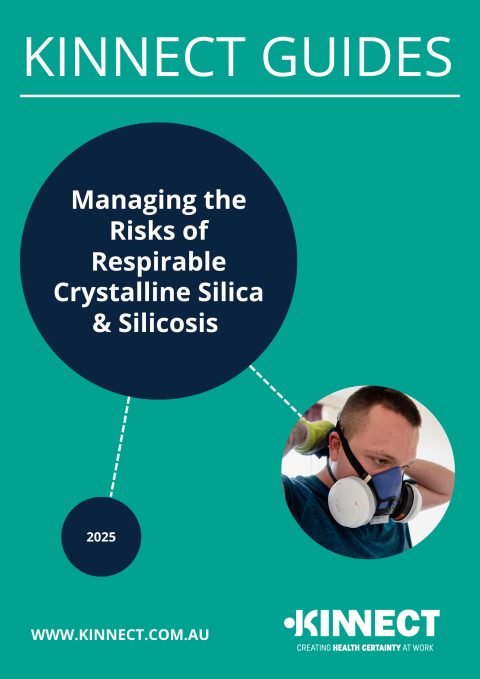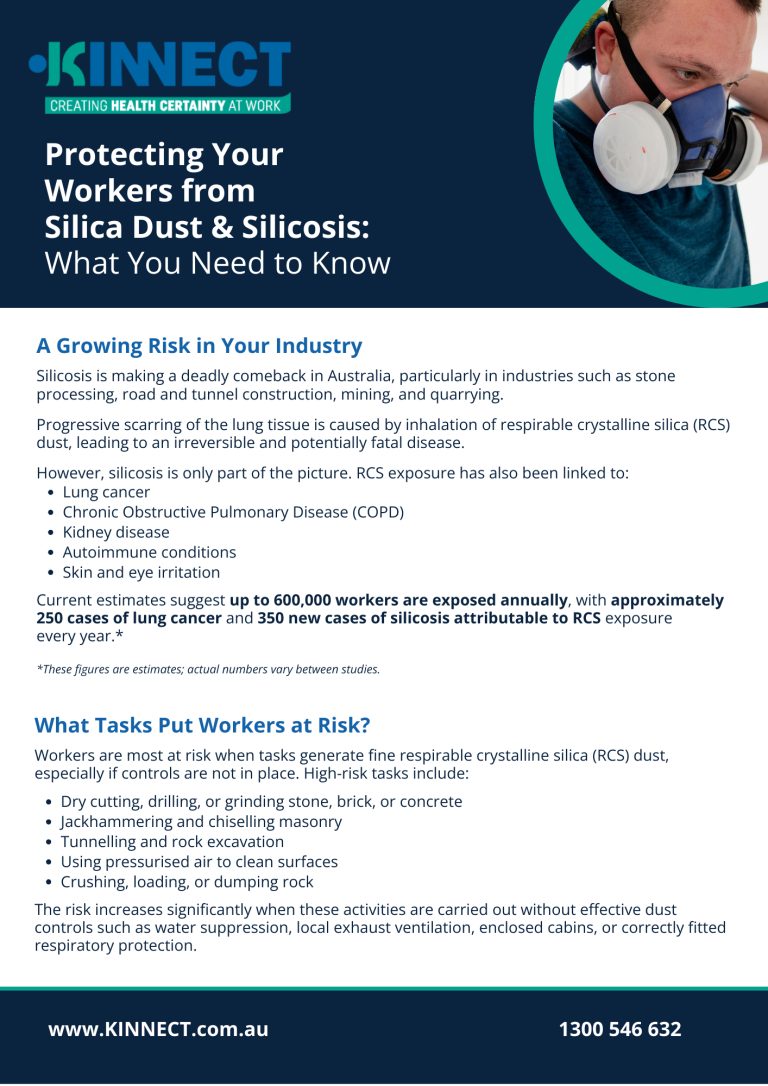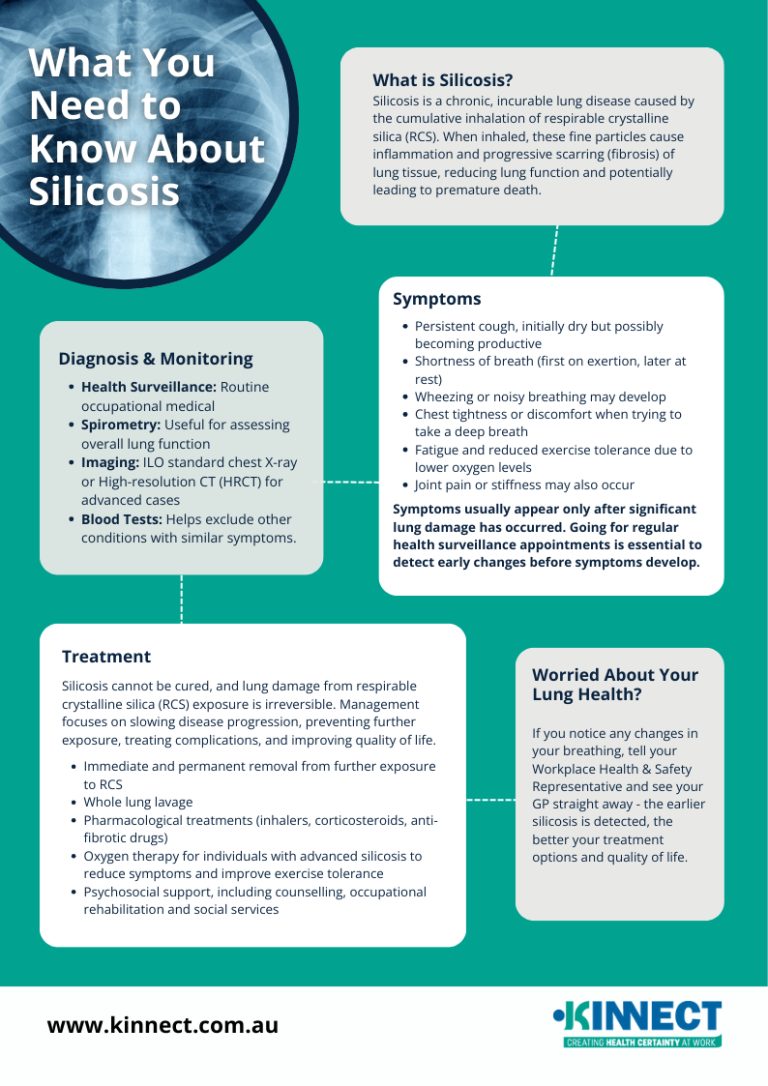A collection of resources to help you understand the risks of
respirable crystalline silica and prevent silicosis.
Respirable crystalline silica (RCS) is one of the most significant occupational health risks confronting Australian industries today. When workers cut, grind, drill, process or tunnel through silica-rich materials, microscopic silica particles become airborne.
Once inhaled, these fine particles can penetrate deep into the lungs and cause silicosis – an incurable and potentially fatal disease marked by progressive scarring of lung tissue. Alarmingly, silicosis is increasingly seen among both younger and older workers.
For employers, managing RCS risks is both a legal obligation and a moral duty. Australia’s regulatory environment has tightened significantly, with lower exposure limits, mandatory health surveillance, and, in some cases, bans on high-risk materials such as engineered stone. Non-compliance exposes organisations to substantial financial penalties, reputational damage and, most importantly, harm to their workforce.
The following resources provide you, as an employer, with the knowledge to create a comprehensive respiratory health protection plan that will ensure you’re compliant with state legislation, protect your workers from silicosis, and reduce compensation claims.
About RCS & Silicosis Legislation Information How KINNECT Can Help
Learn About Respirable Crystalline Silica (RCS) & Silicosis
Comprehensive Guide
Managing the Risks of Respirable Crystalline Silica & Silicosis
Prepared under the guidance of KINNECT’s Chief Medical Officer, Dr Matthew Brandt, this 13-page document provides practical strategies, compliance advice and health monitoring requirements to help employers:
- Understand how silicosis is contracted, diagnosed and managed
- Meet evolving regulatory and legislative standards
- Protect their workers from RCS exposure

Short Guide
Protecting Your Workers from Silica Dust & Silicosis
This 4-page summary of the comprehensive guide ‘Managing the Risks of Respirable Crystalline Silica & Silicosis’ outlines:
- The risks associated with exposure to RCS
- Which tasks put workers most at risk
- Legislation and WHS guidelines and your responsibilities as an employer
- Best practice health monitoring
- What to do if a worker has silicosis

Printable A2 Posters
Simple, clear information about the risks of RCS exposure for workers
Ready to download, print and hang in your workplace, there are two posters available:
Poster 1 – What You Need to Know About Silicosis describes what silicosis is, the symptoms, diagnosis and treatment
Poster 2 – Your Guide to Preventing Silicosis lists simple ways that workers can protect themselves from RCS exposure and limit the risk of silicosis

Videos
Controlling the Risks of RCS & Silicosis
WHS Legislation for Managing the Risks of Respirable Crystalline Silica
Australian work health and safety laws require employers to implement robust risk management processes — including elimination or minimisation of RCS exposure, effective dust controls, and ongoing health surveillance for at-risk workers. These measures form the cornerstone of both compliance and worker protection.
All PCBU’s that expose workers to RCS must adhere to the Workplace Exposure Standard for RCS, which is 0.05 mg/m³ (eight-hour time-weighted average over a five-day working week). The WES must not be exceeded.
The Code of Practice on managing the risks of respirable crystalline silica (RCS) in the workplace provides practical guidance on how to achieve the standards of work health and safety required under the WHS Act and the Work Health and Safety Regulations (the WHS Regulations) and effective ways to identify and manage risks associated with RCS.
Below you’ll find links to the relevant guidelines for your state.
We also encourage you to access Safe Work Australia’s Clean Air. Clear Lungs. page and their Silica Resources Page.
New South Wales
South Australia
Western Australia
Other Resources
How KINNECT Can Help
KINNECT offers compliant occupational health services to help employers stay compliant with current legislation and protect their workers from silicosis.
These services are overseen by:
- Dr Matthew Brandt, KINNECT’s Chief Medical Officer, Consulting Occupational & Environmental Physician and Fellow (Specialist) of the Australasian Faculty of Occupational and Environmental Medicine (AFOEM)
- Dr Graeme Edwards, a Senior Consulting Occupational & Environmental Physician and and Fellow (Specialist) of the Australasian Faculty of Occupational and Environmental Medicine (AFOEM). Dr Edwards was a member of the National Dust Disease Taskforce, which informed a national approach to the prevention, early identification, control and management of dust diseases in Australia, including silicosis (read the final report here)
Respirable Crystalline Silica Medicals
KINNECT holds extensive experience in delivering and monitoring of RCS medicals and currently coordinates programs for many large multinational organisations working in the tunnelling, mining, and construction industries.
KINNECT’s RCS Medicals are overseen by Occupational Health Doctors with extensive experience (25 years+), providing pre-employment medicals, hazardous substance surveillance, injury management and other occupational health services. They hold a competency level 4 in health surveillance for all hazardous substances, including RCS.
Respirator Fit Testing
KINNECT offers accurate and efficient Respirator Fit Testing onsite and in our clinics to protect the respiratory health of your workers with complete confidence.
We can test all disposable respirators and most major reusable respirator brands, including 3M, Moldex, Sundstrom, and Draeger. Fit testing for other brands such as Honeywell, Pro Choice, Maxiguard, and Scott can also be arranged if required; however, in some cases, the appropriate adapter may need to be sourced beforehand.
Our testing is overseen by Drew Bettison, a consultant with RESP-FIT Accreditation (An AIOH Program).
Upskill with Programs from KINNECT Training
Respiratory Protection Equipment (RPE) Awareness
By promoting long-term health and well-being this program empowers workers with knowledge and encourages safe practices. This Respiratory Protection Awareness Program contributes to compliance with regulatory standards and can prove to be an invaluable asset for both workers and employers.
Asbestos & Silica Awareness Online Course Bundle
Combining two short online courses, this bundle is designed to help individuals working in high-risk industries understand the hazards of airborne contaminants. Each module is self-paced and takes between 40 and 45 minutes to complete.
Respiratory Protection Programs – Development & Implementation
Designed for businesses that are required to provide respiratory protective equipment to staff, this program explains all the requirements outlined in the Standard so you can create a robust Respiratory Protection Program that reflects your business’s commitment to respiratory safety in the workplace.



